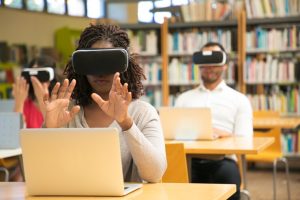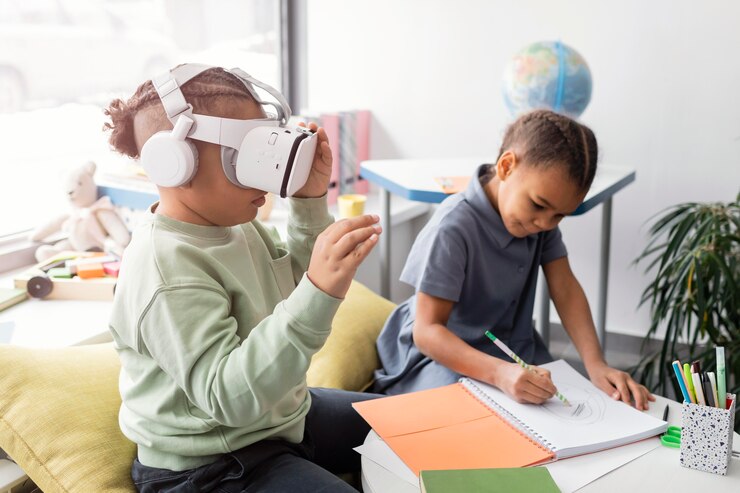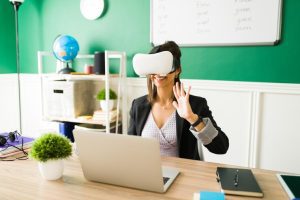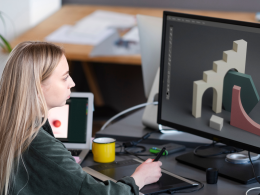In the realm of education, innovative technologies are reshaping how students interact with the world around them. Virtual Reality (VR) and Augmented Reality (AR) are at the forefront, providing immersive experiences that extend far beyond traditional teaching methods. These technologies enable a new form of learning, where students can embark on virtual field trips, explore complex concepts in three dimensions, and gain insights into different cultures.
The Rise of Virtual Reality in Education
The concept of using VR in education may seem futuristic, akin to the 1966 film “Fantastic Voyage,” where a crew embarks on an incredible journey inside the human body. However, what was once science fiction is now a reality in schools across the globe. Students can virtually travel to the Roman Colosseum, explore outer space, and navigate the intricate structures of biological cells, all from the confines of their classroom.
Challenges and Opportunities
Despite the benefits, not all educators have embraced VR and AR fully. Concerns range from the cost of technology and administrative pushback to issues like equipment bulkiness and content availability. Yet, as reported by EdTech, these challenges have not stifled the growing demand for immersive technologies in education. It’s crucial for educators to understand the incredible potential VR and AR hold in transforming the learning experience.
What Are Virtual Reality and Augmented Reality?

Before diving into the advantages of VR and AR, it’s important to differentiate between the two. Augmented Reality overlays digital information onto the real world through devices like smartphones, providing an interactive learning layer. In contrast, Virtual Reality transports users into an entirely virtual environment, offering a 360-degree experience that can simulate real-world scenarios and beyond.
Benefits of Virtual Reality in Education: Explained with Examples
Virtual Reality (VR) and Augmented Reality (AR) provide transformative educational experiences, significantly enhancing the teaching and learning process. Here’s how these benefits play out in real-world scenarios:
Immersive Learning Experiences
Example: A high school history class can use VR virtually visit Ancient Rome. Students don’t just read about the Colosseum; they can walk through its corridors, visualize gladiator games, and explore ancient Roman life interactively. This kind of immersive environment makes historical events come alive, allowing students to experience them as if they were present, which can significantly enhance engagement and retention of information.
Enhanced Creativity and Imagination
Example: In a creative writing course, students can explore fantastical worlds using VR. Imagine students stepping into a 3D rendering of a fictional universe inspired by novels they’re reading. This experience can ignite their imagination, helping them to create their own stories with enriched backgrounds, detailed settings, and compelling narratives. By engaging with these virtual environments, students can visualize scenes that inspire new ideas and creative solutions.
Understanding Complex Concepts
Example: Consider a biology class where students use VR to dive into the human body’s circulatory system. Instead of static textbook diagrams, they can virtually travel alongside red blood cells to observe how oxygen is transported. This hands-on approach allows students to manipulate and interact with 3D models, making complex processes like cellular respiration or the workings of the immune system more tangible and easier to grasp.
Cultural Competence
Example: Through VR, geography students can embark on virtual field trips around the world. For instance, they can ‘travel’ to Peru to learn about the Inca culture, or visit China to explore the Great Wall. By virtually immersing themselves in different cultural settings, students gain a deeper appreciation for global diversity. This exposure helps build empathy and understanding, essential skills in an increasingly interconnected world.
Improved Student Outcomes
Example: In a study on VR use in education, students in a biology classroom using mixed reality technologies performed better in exams compared to their peers who learned through traditional methods. By participating in immersive simulations, students showed a higher rate of information retention and were able to recall complex biological processes more accurately. This improvement demonstrates how VR and AR not only make learning more engaging but also enhance cognitive outcomes.
Certainly! Here are some detailed examples illustrating how Virtual Reality (VR) Augmented Reality (AR) can be integrated into different areas of the curriculum to enhance educational experiences:
Science Labs

Example: In a chemistry class, students may be eager to learn about chemical reactions that are too dangerous or costly to perform in a typical school lab. With VR, they can virtually mix volatile chemicals like sodium and water, witnessing the explosive reaction firsthand without any risk. Similarly, students can explore complex molecular structures in 3D, providing a deeper understanding of chemical bonds and reactions.
Outcome: This virtual environment allows students to experiment freely, nurturing curiosity and fostering a deeper understanding of scientific principles without safety concerns or budget constraints.
Language Lessons
Example: When learning French, students can be placed in a VR simulation of a Parisian café. They can practice ordering food, asking for directions, and engaging in dialogues with virtual French speakers in real-time. This immersive setting contextualizes vocabulary and phrases, making language learning practical and memorable.
Outcome: Students develop better pronunciation and conversational skills as they immerse themselves in authentic cultural contexts, thus increasing their fluency and confidence in the language being learned.
Art Classes
Example: Art students can use VR to visit renowned galleries such as the Louvre or the Rijksmuseum without leaving their classroom. They can examine famous paintings and sculptures in detail, understanding the artist’s techniques, styles, and historical context. VR tools can also allow students to create their own 3D art pieces, manipulating shapes and colors in a virtual space.
Outcome: Exposure to world-class art provides inspiration and a more profound appreciation for different artistic movements and histories, while the ability to create virtually encourages experimentation and innovation in personal art projects.
Integrating Virtual Reality (VR) and Augmented Reality (AR) into educational settings provides an array of enhancements to learning opportunities, effectively transforming how students interact with educational content. Here’s a breakdown of how VR and AR amplify these experiences:
Increased Engagement
Example: Imagine a geography class where students use VR headsets to explore the Amazon Rainforest. They can virtually walk through dense jungle paths, observe exotic wildlife, and even listen to the sounds of their environment. This immersive experience keeps students focused and excited about the lesson, compared to simply reading about it in textbooks.
Outcome: The engaging nature of VR and AR captures students’ attention, making learning sessions more enjoyable and memorable. When students are actively involved in their learning process, they are more likely to retain information.
Personalized Learning
Example: In mathematics, students may have varying levels of understanding. Using AR, a teacher can offer interactive problem-solving sessions where students receive immediate feedback tailored to their specific learning needs. Slower learners can revisit concepts at their own pace, while advanced students can explore more challenging problems.
Outcome: VR and AR technologies support differentiated instruction, allowing students to progress according to their own learning speeds and interests. This individualized approach accommodates diverse learning styles and encourages deeper exploration of subjects.
Real-World Connection
Example: In a business studies class, AR can simulate real-world business environments. Students can test management strategies in a virtual company, learning about customer behavior, financial management, and marketing in a risk-free setting.
Outcome: By bridging the gap between theoretical learning and practical application, VR and AR provide students with experiences that are relevant to real-world scenarios. This contextual learning helps students make connections between what they learn in school and how it applies to everyday situations.
Development of Critical Skills
Example: In a group project, students might use VR to collaboratively solve a logistical problem, such as planning a cityscape. They must work together to organize resources, negotiate decisions, and creatively solve spatial challenges.
Outcome: As students navigate complex virtual scenarios, they develop essential skills such as problem-solving, teamwork, communication, and innovation. These skills are vital in modern educational settings and professional environments.
Expanding Educational Boundaries
Example: The traditional education model may limit access to certain experiences due to geographical, financial, or safety concerns. For example, a science class could virtually visit a lab in Antarctica to study climate change impacts first-hand without leaving their school.
Outcome: By allowing students to go beyond the classroom’s four walls both literally and figuratively, VR and AR make the impossible possible. This expansion of educational opportunities ensures that students gain a more comprehensive and enriched understanding of the world.
Ultimately, the integration of VR and AR into curricula empowers educators to deliver robust, dynamic, and meaningful educational experiences. These cutting-edge technologies equip students with the skills and knowledge necessary to thrive in today’s digital and interconnected world, transforming education for the better.
Becoming an Innovative Education Leader
With educational technologies evolving, teachers can leverage these tools to enhance student learning. By incorporating VR and AR, educators can transform classrooms into interactive learning hubs, aligning with modern educational standards.
Comparative Analysis: AR vs. VR in Education
| Feature/Aspect | Augmented Reality (AR) | Virtual Reality (VR) |
|---|---|---|
| Environment | Real world with digital layer | Fully immersive digital world |
| Equipment | Smart devices (tablets/phones) | VR headsets (e.g., Oculus, Vive) |
| Interactivity | Overlays digital content on physical surroundings | Complete interaction with digital environment |
| Example Applications | Geometry apps showing 3D models | Virtual tours, historical re-enactments |
| Cost | Generally lower cost | Can be more expensive |
| Immediacy | Augmented real-world interactions | Transports users to different places or times |
| Suitability for Topics | Best for real-world applications and augmenting curriculum | Excellent for immersive storytelling and detailed visual topics |
Conclusion
The integration of Virtual Reality in education provides limitless opportunities for educational growth and innovation. While challenges remain, the potential benefits of enhanced student engagement, creativity, and understanding make VR a pivotal tool in modern education. As programs like American University’s Master of Arts in Teaching prepare educators to lead with technology, the future of learning looks undeniably immersive and interconnected.
By embracing VR and AR, educators can create rich, diverse, and culturally aware learning experiences, preparing students for a dynamic and digitally-driven world. Whether through virtual field trips or interactive lessons, the impact of VR in the classroom is profound, offering new pathways for exploration and understanding.












